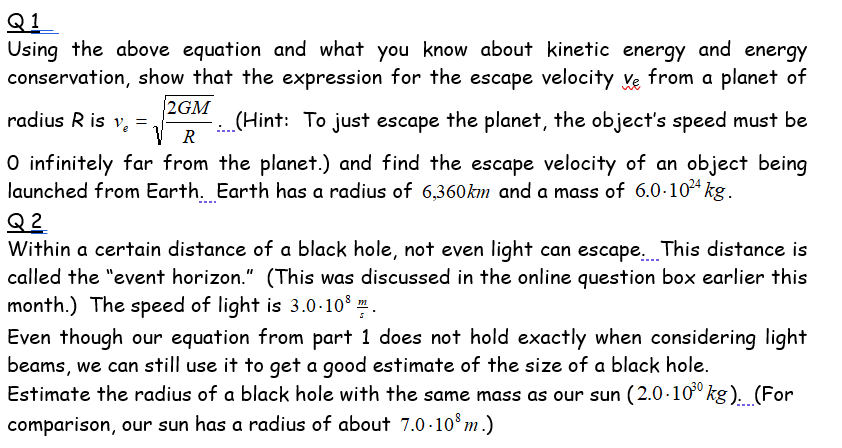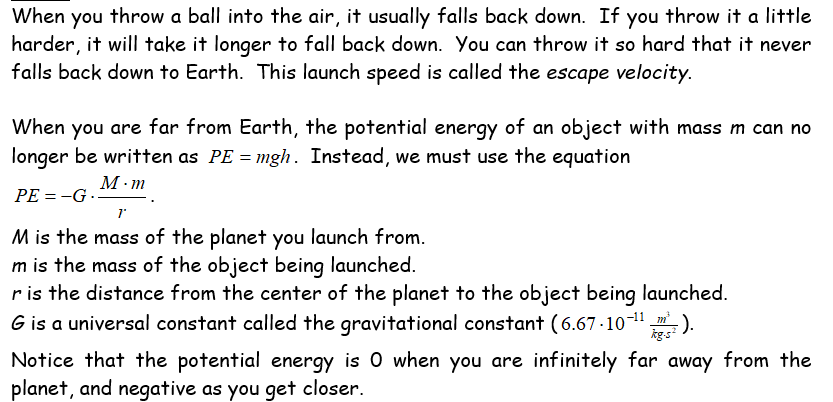Q1 Using the above equation and what you know about kinetic energY and energy conservation, show that the expression for the escape velocity ve from a planet of 2GM radius R is v, = (Hint: To just escape the planet, the object's speed must be R ... O infinitely far from the planet.) and find the escape velocity of an object being launched from Earth. Earth has a radius of 6,360km and a mass of 6.0·10* kg.
Q1 Using the above equation and what you know about kinetic energY and energy conservation, show that the expression for the escape velocity ve from a planet of 2GM radius R is v, = (Hint: To just escape the planet, the object's speed must be R ... O infinitely far from the planet.) and find the escape velocity of an object being launched from Earth. Earth has a radius of 6,360km and a mass of 6.0·10* kg.
College Physics
10th Edition
ISBN:9781285737027
Author:Raymond A. Serway, Chris Vuille
Publisher:Raymond A. Serway, Chris Vuille
Chapter5: Energy
Section: Chapter Questions
Problem 80AP: A 5.0-kg block is pushed 3.0 m up a vertical wall with constant speed by a constant force of...
Related questions
Question

Transcribed Image Text:Q1
Using the above equation and what you know about kinetic energy and energy
conservation, show that the expression for the escape velocity Ye from a planet of
2GM
radius R is v, =
V R
(Hint: To just escape the planet, the object's speed must be
O infinitely far from the planet.) and find the escape velocity of an object being
launched from Earth. Earth has a radius of 6,360km and a mass of 6.0-10* kg.
Q 2
Within a certain distance of a black hole, not even light can escape. This distance is
called the "event horizon." (This was discussed in the online question box earlier this
month.) The speed of light is 3.0-10° .
Even though our equation from part 1 does not hold exactly when considering light
beams, we can still use it to get a good estimate of the size of a black hole.
Estimate the radius of a black hole with the same mass as our sun (2.0 ·10º kg). (For
comparison, our sun has a radius of about 7.0 ·10°m .)

Transcribed Image Text:When you throw a ball into the air, it usually falls back down. If you throw it a little
harder, it will take it longer to fall back down. You can throw it so hard that it never
falls back down to Earth. This launch speed is called the escape velocity.
When you are far from Earth, the potential energy of an object with mass m can no
longer be written as PE = mgh. Instead, we must use the equation
М-т
PE = -G ..
1"
M is the mass of the planet you launch from.
m is the mass of the object being launched.
r is the distance from the center of the planet to the object being launched.
G is a universal constant called the gravitational constant (6.67-10-" ).
kg-s
Notice that the potential energy is 0 when you are infinitely far away from the
planet, and negative as you get closer.
Expert Solution
This question has been solved!
Explore an expertly crafted, step-by-step solution for a thorough understanding of key concepts.
This is a popular solution!
Trending now
This is a popular solution!
Step by step
Solved in 4 steps

Knowledge Booster
Learn more about
Need a deep-dive on the concept behind this application? Look no further. Learn more about this topic, physics and related others by exploring similar questions and additional content below.Recommended textbooks for you

College Physics
Physics
ISBN:
9781285737027
Author:
Raymond A. Serway, Chris Vuille
Publisher:
Cengage Learning

University Physics Volume 1
Physics
ISBN:
9781938168277
Author:
William Moebs, Samuel J. Ling, Jeff Sanny
Publisher:
OpenStax - Rice University

College Physics
Physics
ISBN:
9781938168000
Author:
Paul Peter Urone, Roger Hinrichs
Publisher:
OpenStax College

College Physics
Physics
ISBN:
9781285737027
Author:
Raymond A. Serway, Chris Vuille
Publisher:
Cengage Learning

University Physics Volume 1
Physics
ISBN:
9781938168277
Author:
William Moebs, Samuel J. Ling, Jeff Sanny
Publisher:
OpenStax - Rice University

College Physics
Physics
ISBN:
9781938168000
Author:
Paul Peter Urone, Roger Hinrichs
Publisher:
OpenStax College

Principles of Physics: A Calculus-Based Text
Physics
ISBN:
9781133104261
Author:
Raymond A. Serway, John W. Jewett
Publisher:
Cengage Learning

Physics for Scientists and Engineers, Technology …
Physics
ISBN:
9781305116399
Author:
Raymond A. Serway, John W. Jewett
Publisher:
Cengage Learning

College Physics
Physics
ISBN:
9781305952300
Author:
Raymond A. Serway, Chris Vuille
Publisher:
Cengage Learning